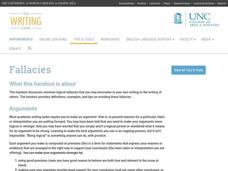American Press Institute
High Five: Go to Press
High school scholars learn valuable information about how to run a newspaper in the third and final installment of a media literacy series. The unit scaffolds learners to success with background information before they plan for...
University of North Carolina
Reading Aloud
Warning: reading your paper aloud may cause bystanders to think you're talking to yourself. However, as the 14th installment of 24 in the Writing the Paper series from UNC explains, it is one of the best strategies for revision. Through...
University of North Carolina
Fallacies
All teacher workrooms contain a coffee maker, therefore all teachers must be addicted to coffee. That sentence represents a logical fallacy (although it may be true from some), a topic the seventh installment in the 24-part Writing the...
University of North Carolina
Gender-Inclusive Language
In the past, if writers weren't sure of a person's gender, they simply used masculine pronouns. Today, however, as a handout on gender-inclusive language explains, writers must choose pronouns carefully. To promote the use of gender...
University of North Carolina
Modals
If you could have any job in the world, what would it be? Modal verbs such as could and would express possibility, as the installment of a compilation of informational handouts describes. A series of tables help explain the strength,...
University of North Carolina
Getting Feedback
As many writers know, you are your own worst editor. The 10th installment in the Writing the Paper series explains that getting feedback from others is crucial to the writing process. The handout highlights the best time to ask others to...
University of North Carolina
Literature (Fiction)
An informative installment of the Writing for Specific Fields series helps readers learn how to interpret and write about fiction. The website details nine easy steps for writing a literary analysis—a useful method for all readers!
Meadows Center for Preventing Educational Risk, University of Texas at Austin
Lesson 3 - Consonant Digraphs
Words such as witch, whack, and wish often cause beginning readers to struggle. The third installments in the Word Recognition and Fluency series of 17, covers consonant digraphs. Activities guide learners through the identification and...
Curated OER
National Gallery of Art: Prinz Friedrich von Homburg: Ein Schauspeil, 3x
Students explore the work of Frank Stella. In this art appreciation lesson, students look at images of the sculpture Prinz Friedrich von Homburg: Ein Schauspeil, 3x and discuss it as a work of art. This lesson includes two simple...
Curated OER
Lesson: Lisa Signal: Altering Perspectives
Kids make big artistic gestures, just like the abstract artist, Lisa Signal. They use her work as inspiration for making simplistic, abstract, statements in an artistic way. They analyze her work, then walk through an unfamiliar...
Curated OER
Expression: Masks - Activity 1
Young scholars create art plans for an "installation" after viewing a video of Native American mask making that centers around the Salmon rack idea. Emphasis is placed on collaborative work in this introductory instructional activity.
Curated OER
Canvas Dinnerware
Take recycling to a new height. Learners use china or plastic dinnerware from thrift stores to create great works of art. They discuss great works of art, talk about techniques, and design their own piece.
Curated OER
The Learning Network: More Like Disney
A great source of high-interest reading for the language arts classroom! Meant to be used with an article also available on the New York Times website, this worksheet provides 10 comprehension questions about the reading as well as one...
Curated OER
Debt
Fourth graders read a book about debt, credit, and interest rates and write a story about these topics. In this debt and credit lesson, 4th graders read the book Four Dollars and Fifty Cents, define the terms "debt" and "credit," and...
Curated OER
Sculptural Space
Young scholars analyze the needs for outdoor sculpture and create their own example. In this sculpture lesson, students discuss the sculptural and architectural elements of site-specific sculpture. Young scholars work in teams to select...
Curated OER
Sailing Vessel Installations
Students identify the parts of sailing vessels. They view pictures of sailing vessels and discuss the purpose of each part. Students build their own installation in class. They share experiences and ideas based on the sailing vessel.
Curated OER
Advocacy, Recognition, Prevention Through Art and Health
Students analyze how the environment and family history impacts personal health. In this personal health lesson, students discuss cancer and survey the school community about the disease. Students create a bulletin board about cancer and...
Curated OER
Superhighway Scholars
Students study the states of their choice by using Superhighway Scholars website. In this Unites States history lesson plan, students create a collage using information collected about a state of their choosing. This lesson plan provides...
Curated OER
Install Bridging
Students measure layout, and cut and install floor bridging to trade standards (100% accuracy) following all safety rules and regulations.
Curated OER
Tennis Shoe Art
Students decorate a pair of tennis shoes. In this art lesson, students use paint to decorate a pair of tennis shoes. Students may also use fabric pens.
Curated OER
Interactive Art: Let's Make It Happen
Pupils examine art by Christopher Janney. They discuss what the art is showing and what it means to them. They create their own piece of interactive art.
Google
Animate a Name
What's in a name? Pupils use the Scratch code blocks to animate letters in a name. They learn about events, sequencing, and loops in computer science by taking part in the project.
Curated OER
Talk to the Hand
Students explore the significance of various body parts in artistic and social expression. They research a body part and create a museum installation depicting the artistic and social significance of the body part throughout history.
Curated OER
Renewable Energy and
Students identify and explore renewable energy options and then research, develop and install a renewable energy system in their school or community. Students identify the use of renewable energy sources in the north, demonstrate their...

























